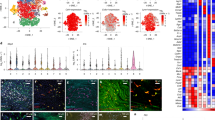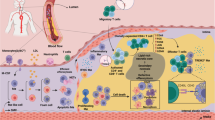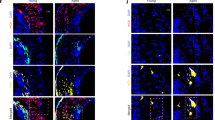Abstract
During the inflammatory response that drives atherogenesis, macrophages accumulate progressively in the expanding arterial wall1,2. The observation that circulating monocytes give rise to lesional macrophages3,4,5,6,7,8,9 has reinforced the concept that monocyte infiltration dictates macrophage buildup. Recent work has indicated, however, that macrophage accumulation does not depend on monocyte recruitment in some inflammatory contexts10. We therefore revisited the mechanism underlying macrophage accumulation in atherosclerosis. In murine atherosclerotic lesions, we found that macrophages turn over rapidly, after 4 weeks. Replenishment of macrophages in these experimental atheromata depends predominantly on local macrophage proliferation rather than monocyte influx. The microenvironment orchestrates macrophage proliferation through the involvement of scavenger receptor A (SR-A). Our study reveals macrophage proliferation as a key event in atherosclerosis and identifies macrophage self-renewal as a therapeutic target for cardiovascular disease.
This is a preview of subscription content, access via your institution
Access options
Subscribe to this journal
Receive 12 print issues and online access
$209.00 per year
only $17.42 per issue
Buy this article
- Purchase on Springer Link
- Instant access to full article PDF
Prices may be subject to local taxes which are calculated during checkout




Similar content being viewed by others
References
Swirski, F.K. & Nahrendorf, M. Leukocyte behavior in atherosclerosis, myocardial infarction, and heart failure. Science 339, 161–166 (2013).
Hansson, G.K. & Libby, P. The immune response in atherosclerosis: a double-edged sword. Nat. Rev. Immunol. 6, 508–519 (2006).
Kim, C.J. et al. Polymerase chain reaction–based method for quantifying recruitment of monocytes to mouse atherosclerotic lesions in vivo: enhancement by tumor necrosis factor-α and interleukin-1β. Arterioscler. Thromb. Vasc. Biol. 20, 1976–1982 (2000).
Lessner, S.M., Prado, H.L., Waller, E.K. & Galis, Z.S. Atherosclerotic lesions grow through recruitment and proliferation of circulating monocytes in a murine model. Am. J. Pathol. 160, 2145–2155 (2002).
Swirski, F.K. et al. Monocyte accumulation in mouse atherogenesis is progressive and proportional to extent of disease. Proc. Natl. Acad. Sci. USA 103, 10340–10345 (2006).
Swirski, F.K. et al. Ly-6Chi monocytes dominate hypercholesterolemia-associated monocytosis and give rise to macrophages in atheromata. J. Clin. Invest. 117, 195–205 (2007).
Tacke, F. et al. Monocyte subsets differentially employ CCR2, CCR5, and CX3CR1 to accumulate within atherosclerotic plaques. J. Clin. Invest. 117, 185–194 (2007).
Combadière, C. et al. Combined inhibition of CCL2, CX3CR1, and CCR5 abrogates Ly6Chi and Ly6Clo monocytosis and almost abolishes atherosclerosis in hypercholesterolemic mice. Circulation 117, 1649–1657 (2008).
Saederup, N., Chan, L., Lira, S.A. & Charo, I.F. Fractalkine deficiency markedly reduces macrophage accumulation and atherosclerotic lesion formation in CCR2−/− mice: evidence for independent chemokine functions in atherogenesis. Circulation 117, 1642–1648 (2008).
Jenkins, S.J. et al. Local macrophage proliferation, rather than recruitment from the blood, is a signature of TH2 inflammation. Science 332, 1284–1288 (2011).
Robbins, C.S. et al. Extramedullary hematopoiesis generates Ly-6Chigh monocytes that infiltrate atherosclerotic lesions. Circulation 125, 364–374 (2012).
Swirski, F.K., Weissleder, R. & Pittet, M.J. Heterogeneous in vivo behavior of monocyte subsets in atherosclerosis. Arterioscler. Thromb. Vasc. Biol. 29, 1424–1432 (2009).
Potteaux, S. et al. Suppressed monocyte recruitment drives macrophage removal from atherosclerotic plaques of Apoe−/− mice during disease regression. J. Clin. Invest. 121, 2025–2036 (2011).
Leuschner, F. et al. Rapid monocyte kinetics in acute myocardial infarction are sustained by extramedullary monocytopoiesis. J. Exp. Med. 209, 123–137 (2012).
Schulz, C. et al. A lineage of myeloid cells independent of Myb and hematopoietic stem cells. Science 336, 86–90 (2012).
Psaltis, P.J. et al. Identification of a monocyte-predisposed hierarchy of hematopoietic progenitor cells in the adventitia of postnatal murine aorta. Circulation 125, 592–603 (2012).
Bunster, E. & Meyer, R.K. An improved method of parabiosis. Anat. Rec. 57, 339–343 (1933).
Liu, K. et al. Origin of dendritic cells in peripheral lymphoid organs of mice. Nat. Immunol. 8, 578–583 (2007).
Zhu, S.N., Chen, M., Jongstra-Bilen, J. & Cybulsky, M.I. GM-CSF regulates intimal cell proliferation in nascent atherosclerotic lesions. J. Exp. Med. 206, 2141–2149 (2009).
Rosenfeld, M.E. & Ross, R. Macrophage and smooth muscle cell proliferation in atherosclerotic lesions of WHHL and comparably hypercholesterolemic fat-fed rabbits. Arteriosclerosis 10, 680–687 (1990).
Gordon, D., Reidy, M.A., Benditt, E.P. & Schwartz, S.M. Cell proliferation in human coronary arteries. Proc. Natl. Acad. Sci. USA 87, 4600–4604 (1990).
Rekhter, M.D. & Gordon, D. Active proliferation of different cell types, including lymphocytes, in human atherosclerotic plaques. Am. J. Pathol. 147, 668–677 (1995).
Katsuda, S., Coltrera, M.D., Ross, R. & Gown, A.M. Human atherosclerosis. IV. Immunocytochemical analysis of cell activation and proliferation in lesions of young adults. Am. J. Pathol. 142, 1787–1793 (1993).
Lutgens, E. et al. Atherosclerosis in APOE*3-Leiden transgenic mice: from proliferative to atheromatous stage. Circulation 99, 276–283 (1999).
Lutgens, E. et al. Biphasic pattern of cell turnover characterizes the progression from fatty streaks to ruptured human atherosclerotic plaques. Cardiovasc. Res. 41, 473–479 (1999).
Aikawa, M. et al. An HMG-CoA reductase inhibitor, cerivastatin, suppresses growth of macrophages expressing matrix metalloproteinases and tissue factor in vivo and in vitro. Circulation 103, 276–283 (2001).
Butcher, M.J., Herre, M., Ley, K. & Galkina, E. Flow cytometry analysis of immune cells within murine aortas. J. Vis. Exp. e2848 (2011).
Gough, P.J. et al. Analysis of macrophage scavenger receptor (SR-A) expression in human aortic atherosclerotic lesions. Arterioscler. Thromb. Vasc. Biol. 19, 461–471 (1999).
Teupser, D. et al. Scavenger receptor activity is increased in macrophages from rabbits with low atherosclerotic response: studies in normocholesterolemic high and low atherosclerotic response rabbits. Arterioscler. Thromb. Vasc. Biol. 19, 1299–1305 (1999).
Hazen, S.L. Oxidized phospholipids as endogenous pattern recognition ligands in innate immunity. J. Biol. Chem. 283, 15527–15531 (2008).
Sakai, M. et al. The scavenger receptor serves as a route for internalization of lysophosphatidylcholine in oxidized low density lipoprotein–induced macrophage proliferation. J. Biol. Chem. 271, 27346–27352 (1996).
Seimon, T.A., Obstfeld, A., Moore, K.J., Golenbock, D.T. & Tabas, I. Combinatorial pattern recognition receptor signaling alters the balance of life and death in macrophages. Proc. Natl. Acad. Sci. USA 103, 19794–19799 (2006).
Heil, M. et al. Blood monocyte concentration is critical for enhancement of collateral artery growth. Am. J. Physiol. Heart Circ. Physiol. 283, H2411–H2419 (2002).
Boesten, L.S. et al. Macrophage retinoblastoma deficiency leads to enhanced atherosclerosis development in ApoE-deficient mice. FASEB J. 20, 953–955 (2006).
Díez-Juan, A. et al. Selective inactivation of p27(Kip1) in hematopoietic progenitor cells increases neointimal macrophage proliferation and accelerates atherosclerosis. Blood 103, 158–161 (2004).
Murphy, A.J. et al. ApoE regulates hematopoietic stem cell proliferation, monocytosis, and monocyte accumulation in atherosclerotic lesions in mice. J. Clin. Invest. 121, 4138–4149 (2011).
Dutta, P. et al. Myocardial infarction accelerates atherosclerosis. Nature 487, 325–329 (2012).
Reed, J.A. et al. Distinct changes in pulmonary surfactant homeostasis in common beta-chain– and GM-CSF–deficient mice. Am. J. Physiol. Lung Cell Mol. Physiol. 278, L1164–L1171 (2000).
Van Rooijen, N. & Sanders, A. Liposome mediated depletion of macrophages: mechanism of action, preparation of liposomes and applications. J. Immunol. Methods 174, 83–93 (1994).
Swirski, F.K. et al. Identification of splenic reservoir monocytes and their deployment to inflammatory sites. Science 325, 612–616 (2009).
Galkina, E. et al. Lymphocyte recruitment into the aortic wall before and during development of atherosclerosis is partially L-selectin dependent. J. Exp. Med. 203, 1273–1282 (2006).
Acknowledgements
We thank M. Greene for secretarial assistance. We thank J. Whitsett at Cincinnati Children's Hospital Medical Center for providing Csf2rb−/− mice. This work was supported in part by US National Institutes of Health grants 1R01HL095612 (to F.K.S.) and HHSN 268201000044C, P01-A154904, U24-CA092782 and P50-CA086355 (to R.W.) and start-up funding provided by the Heart and Stroke Richard Lewar Centre of Excellence in Cardiovascular Research and the Department of Laboratory Medicine and Pathobiology, University of Toronto (to C.S.R.). C.S.R. was supported by the Massachusetts General Hospital Executive Committee on Research (ECOR) Postdoctoral Award. G.F.W. and I.H. were supported by the German Research Foundation. I.T. was supported by the Max Kade Foundation. L.M.S.G. was supported by the Boehringer Ingelheim Funds.
Author information
Authors and Affiliations
Contributions
C.S.R. and I.H. conceived the project, designed and performed experiments, and analyzed and interpreted data. G.F.W., I.T., L.M.S.G., D.S., C.C.J.Z. and E.A.S. performed experiments and helped interpret the data. J.-L.F., R.G. and I.H. performed animal surgeries. Y.I. performed the immunofluorescence histology and immunohistochemistry. M.P. performed ImageStreamX Mark II studies. G.K.S., P.L., M.N., M.H. and R.W. provided materials, intellectual input and edited the manuscript. N.v.R. provided clodronate liposomes. H.Y.L. edited the manuscript. F.K.S. conceived the project, designed experiments and supervised the study. C.S.R. and F.K.S. wrote the manuscript.
Corresponding authors
Ethics declarations
Competing interests
The authors declare no competing financial interests.
Supplementary information
Supplementary Text and Figures
Supplementary Figures 1–6 (PDF 1936 kb)
Rights and permissions
About this article
Cite this article
Robbins, C., Hilgendorf, I., Weber, G. et al. Local proliferation dominates lesional macrophage accumulation in atherosclerosis. Nat Med 19, 1166–1172 (2013). https://doi.org/10.1038/nm.3258
Received:
Accepted:
Published:
Issue Date:
DOI: https://doi.org/10.1038/nm.3258
This article is cited by
-
Macrophage profiling in atherosclerosis: understanding the unstable plaque
Basic Research in Cardiology (2024)
-
TREM2 protects from atherosclerosis by limiting necrotic core formation
Nature Cardiovascular Research (2024)
-
Anti-inflammatory therapy of atherosclerosis: focusing on IKKβ
Journal of Inflammation (2023)
-
Macrophage-specific autophagy-related gene HSPB8 is involved in the macrophage polarization in atherosclerosis
BMC Cardiovascular Disorders (2023)
-
Role of galectin-3 in diagnosis and severity assessment of epicardial artery lesions in patients with suspected coronary artery disease
BMC Cardiovascular Disorders (2023)



